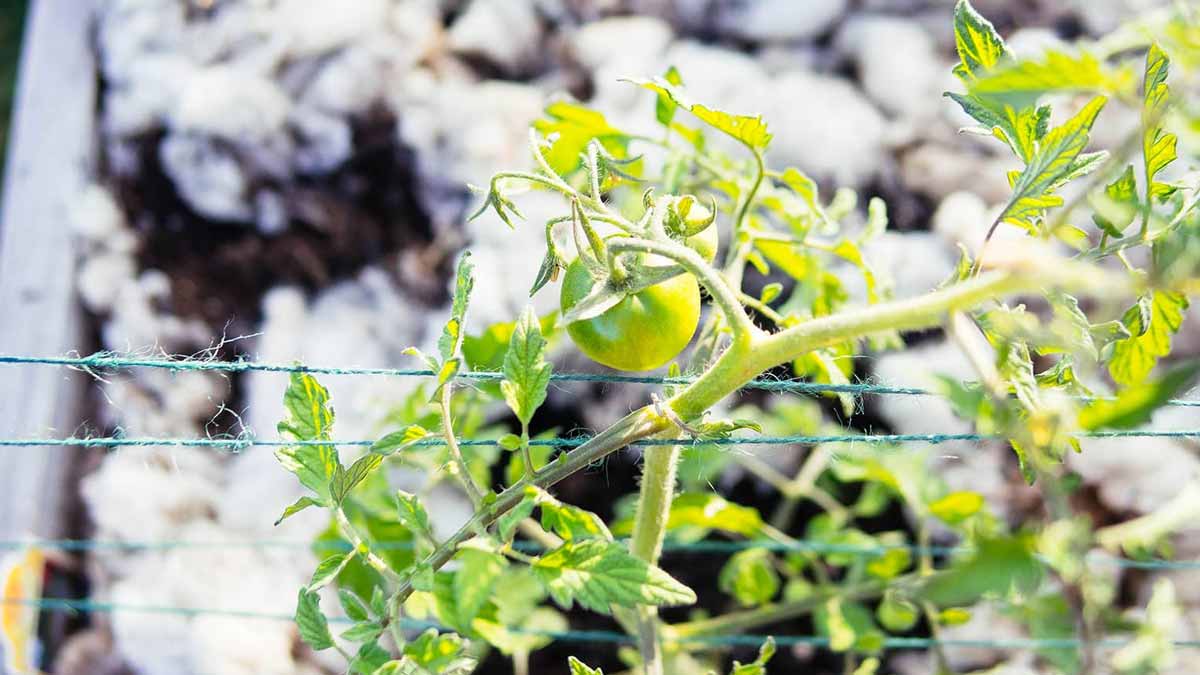Strong, tidy vines start with the right support, not extra work. The Florida weave replaces bulk with clean lines, and because it scales, beginners feel confident while seasoned growers save time. From two end stakes to looping twine, the system keeps stems upright and fruit reachable. You guide growth, reduce breakage, and still keep airflow. And since every choice matters in a small plot, tomato support that is simple and sturdy changes the whole season.
Why The Florida Weave Beats Flimsy Cages For tomato Rows
Set the scene: fruiting vines need structure to stop bending and snapping. The Florida weave uses only two stakes at the ends of a row as anchors for twine. That lean setup stabilizes multiple plants at once, so beds stay neat. It also limits clutter, which helps you move freely between rows during watering and mulching.
Compared with a single-stake method, where each plant gets its own pole, the weave cuts hardware and effort. You tie one line, then guide growth across the row. Because the system shares support, stems stay centered and branches are gathered in a gentle cradle. That reduces wind damage without rigid hardware.
The layout improves airflow while still containing side shoots. Good circulation lowers disease pressure and keeps leaves drier after rain. Harvest gets easier as fruit clusters stay visible and reachable. With less metal and fewer parts, the routine also fits tight budgets and time-pressed gardeners who value tomato order.
How The Weave Works Step By Step
Start at the first end stake and knot strong garden twine. Run the line along the row, pass in front of the first plant, then behind the next, in a simple back-and-forth path. Loop the end stake, then return along the row on the opposite side, which creates a paired line that steadies every stem.
Those twin passes “sandwich” each plant between twine, keeping the main stem and branches in place. As growth climbs, add fresh levels a little higher, creating successive loops at practical heights. The flexible lattice adapts as you go, rather than forcing plants to fit a fixed frame that can pinch or topple in storms.
Two end stakes act as durable anchors; bamboo stakes work well and stay light. Because tension matters, keep lines snug yet not tight. Add levels after a flush of growth or a windy week. The result is a clean corridor where you can prune lightly, check ties quickly, and guide each tomato vine without fuss.
Choosing Varieties And Care That Suit tomato Support
Shorter, outward-branching types shine here. Many paste and sauce strains used for canning carry stocky growth and clustered fruit, which the weave holds cleanly. Some cherry and grape types also fit because their branching spreads rather than racing skyward. The grid keeps clusters off soil while still letting light reach interior leaves.
Plants that don’t benefit from frequent removal of branches and suckers are prime candidates. The weave contains that natural sprawl without heavy pruning. You still tidy where needed, yet you avoid constant pinching that steals time. The balance suits busy schedules and cuts the risk of tearing tender tissue during hot, dry spells.
Spacing still matters because crowding invites mildew and sap-sucking pests. Leave comfortable walkways and steady end stakes, then let the string lines do the rest. Because the system manages several vines together, care feels coordinated. Feeding, light pruning, and quick tie-ups happen in one pass, which keeps your tomato routine efficient.
What Cages Still Do Well And Where They Fail
Cages can help contain branches; however, many store-bought frames are flimsy, lightweight, and too short. Tall vines often exceed 4 to 8 feet, so tops bend or break above the rim. When frames wobble, stems rub the wire and bruise, which slows growth and complicates ripening during the warmest stretch.
Because wire walls crowd foliage, airflow can suffer. Stale air traps moisture, so leaf disease spreads faster, and fruit hides deep inside the ring. Harvest then turns awkward as hands fight the grid. Even careful picking can knock unripe clusters loose, which wastes energy the plant could send to coloring fruit.
That said, cages are simple to install and suit a set-and-forget style. Push them in once and you’re mostly done until picking time. For very small plantings, convenience may outweigh limits. Yet for a longer row, the weave’s shared lines keep space open, ties quick, and every tomato within easy reach.
Practical Setup, Spacing, Airflow, And Harvest Ease
Use two sturdy end stakes to anchor twine; many gardeners favor smooth bamboo like Martha Stewart’s go-to option. Drive each stake deep for stability. Choose a thick, UV-resistant twine that doesn’t bite stems. Check tension after big winds, then add the next level before growth flops and rubs against the soil.
Work down the row in calm weather so lines sit neat. Keep the lower run just above the first sets of branches; add the next as trusses form. Because the weave is modular, you scale support with growth rather than gambling on a one-size cage. The pathway stays open for watering and hand weeding.
Remember: there isn’t only one method. Gardeners use single stakes, cages, and various trellises with success. The choice depends on variety, plant spacing, and how much care you want to give. As one respected coach notes, match support to how you plan to prune and tend each tomato through the season’s demands.
A Simple Way To Finish Strong Without Added Clutter
Season after season, structure shapes success. The Florida weave gives clean lines, quick ties, and steady airflow, while cages trade ease of setup for limits in height and access. Choose the method that fits your varieties, spacing, and time. If your goal is neat rows and stress-free picking, tomato vines thrive on a good weave.
